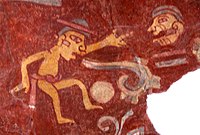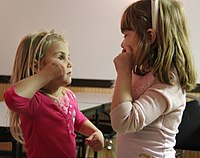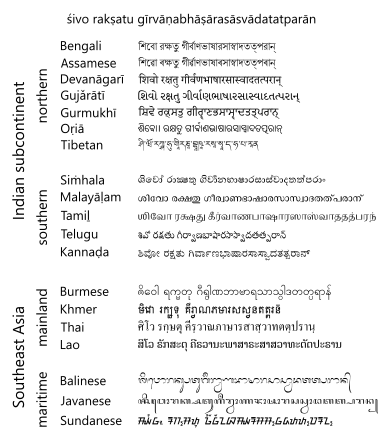Portal:Language
Introduction




Language is a structured system of communication that consists of grammar and vocabulary. It is the primary means by which humans convey meaning, both in spoken and written forms, and may also be conveyed through sign languages. Human language is characterized by its cultural and historical diversity, with significant variations observed between cultures and across time. Human languages possess the properties of productivity and displacement, which enable the creation of an infinite number of sentences, and the ability to refer to objects, events, and ideas that are not immediately present in the discourse. The use of human language relies on social convention and is acquired through learning.
Estimates of the number of human languages in the world vary between 5,000 and 7,000. Precise estimates depend on an arbitrary distinction (dichotomy) established between languages and dialects. Natural languages are spoken, signed, or both; however, any language can be encoded into secondary media using auditory, visual, or tactile stimuli – for example, writing, whistling, signing, or braille. In other words, human language is modality-independent, but written or signed language is the way to inscribe or encode the natural human speech or gestures.
Depending on philosophical perspectives regarding the definition of language and meaning, when used as a general concept, "language" may refer to the cognitive ability to learn and use systems of complex communication, or to describe the set of rules that makes up these systems, or the set of utterances that can be produced from those rules. All languages rely on the process of semiosis to relate signs to particular meanings. Oral, manual and tactile languages contain a phonological system that governs how symbols are used to form sequences known as words or morphemes, and a syntactic system that governs how words and morphemes are combined to form phrases and utterances.
The scientific study of language is called linguistics. Critical examinations of languages, such as philosophy of language, the relationships between language and thought, how words represent experience, etc., have been debated at least since Gorgias and Plato in ancient Greek civilization. Thinkers such as Jean-Jacques Rousseau (1712–1778) have argued that language originated from emotions, while others like Immanuel Kant (1724–1804) have argued that languages originated from rational and logical thought. Twentieth century philosophers such as Ludwig Wittgenstein (1889–1951) argued that philosophy is really the study of language itself. Major figures in contemporary linguistics of these times include Ferdinand de Saussure and Noam Chomsky. (Full article...)
Selected language -
Nafaanra (sometimes written Nafaara, pronounced [nafãːra]), also known as Nafanan or Nafana, is a Senufo language spoken in northwest Ghana, along the border with Ivory Coast, east of Bondoukou. It is spoken by approximately 90,000 people. Its speakers call themselves Nafana, but others call them Banda or Mfantera. Like other Senufo languages, Nafaanra is a tonal language. It is somewhat of an outlier in the Senufo language group, with the geographically-closest relatives, the Southern Senufo Tagwana–Djimini languages, approximately 200 kilometres (120 mi) to the west, on the other side of Comoé National Park.
The basic word order is subject–object–verb, like Latin and Japanese. Like other Niger–Congo languages, it has a noun class system, with nouns classified according to five different classes, which also affects pronouns, adjectives and copulas. The phonology features a distinction between the length of vowels and whether they are oral or nasal (as in French or Portuguese). There are also three distinct tones, a feature shared with the other Senufo languages. Nafaanra grammar features both tense and aspect which are marked with particles. Numbers are mainly formed by adding cardinal numbers to the number 5 and by multiplying the numbers 10, 20 and 100. (Full article...)Did you know (auto-generated)

- ... that the Swiss Youth Symphony Orchestra was founded in 1969 for members from all four Swiss language regions, and meets twice a year for rehearsals and a tour program?
- ... that Kannada-language author M. V. Seetharamiah established that the Rashtrakuta emperor Nrupatunga did not write the classic Kavirajamarga?
- ... that the author of In the Land of Invented Languages lived in the same town as a fluent Klingon speaker?
- ... that Alexander Atabekian published the first anarchist periodical in the Armenian language?
- ... that foreign nationals wishing to gain Philippine citizenship need to demonstrate proficiency in English or Spanish as well as a Philippine language?
- ... that History of the Mission of the Evangelical Brothers in the Caribbean by C. G. A. Oldendorp was the first book to publish Igbo-language terms in 1777?
More did you know -
- ...that the totem pole (pictured) which welcomes visitors to the British Museum was documented for the museum by Rev. John Henry Keen years before it was purchased?
- ...that Missouri French is a nearly extinct dialect of French that developed in what is now the midwestern United States during the colonial period?
- ...that Hindi, Bengali, and Portuguese were all proposed as official languages of the United Nations?
- ...that the Vedda language is a Creole based on Sinhalese of Sri Lanka instead of a dialect?
Categories
Linguistics: Computational linguistics • Grammar • Historical linguistics • Morphology • Phonetics • Phonology • Pragmatics • Reading • Semantics • Sociolinguistics • Syntax • Writing
Languages: Language families • Pidgins and creoles • Sign languages
Linguists: By nationality • Historical linguists • Morphologists • Phoneticians • Phonologists • Sociolinguists • Syntacticians • Translators
Stubs: Constructed languages • Languages • Linguists • Pidgins and creoles • Typography • Vocabulary and usage • Writing systems
Full Language category tree
|
|---|
|
Select [►] to view subcategories
|
Related portals
Selected topic -
Articles 4 and 114 of the Constitution of Latvia form the foundation for language policy in Latvia, declaring Latvian to be the official state language and affirming the rights of ethnic minorities to preserve and develop their languages. Livonian language is recognized as "the language of the indigenous (autochthon) population" in the Official Language Law, but Latgalian written language is protected as "a historic variant of Latvian." All other languages are considered foreign by the Law on State Language (Official Language Law in other translations). Latvia provides national minority education programmes in Russian (the first language for over one third of the population), Polish, Hebrew, Ukrainian, Estonian, Lithuanian, and Belarusian.
The preamble to the Official Language Law includes as its goals "the integration of members of ethnic minorities into the society of Latvia, while observing their rights to use their native language or other languages; [and] the increased influence of Latvian in the cultural environment of Latvia, to promote a more rapid integration of society." (Full article...)Selected picture -

Countries and regions where Portuguese has official status
Language News
- 25 April 2024 – International reactions to the Israel–Hamas war
- The Arabic language spokesperson of the United States Department of State resigns in opposition to U.S. Gaza policy. (Reuters)
- 1 January 2024 – Public Domain Day
- The animated short film Steamboat Willie, the German-language version of the novel All Quiet on the Western Front, and other works published in 1928 enter the public domain in the United States. (Mashable)
Topics

Languages of Africa: Arabic, Chadic, Cushitic, Kanuri, Maasai, Setswana, Swahili, Turkana, Xhosa, Yoruba, Zulu, more...
Languages of the Americas: Aleut, Carib, Cherokee, Inuktitut, Iroquois, Kootenai, Mayan, Nahuatl, Navajo, Quechuan, Salish, American Sign Language, more...
Languages of Asia: Arabic, Assamese, Balochi, Bengali, Chinese, Japanese, Hajong, Hebrew, Hindustani, Kannada, Kokborok, Marathi, Khasi, Korean, Kurdish, Malayalam, Manipuri, Meithei, Mongolian, Persian, Rajasthani, Sindhi, Sanskrit, Sylheti, Tamil, Tanchangya, Tulu, Telugu, Tibetan, Thai, Turkish, Vietnamese, Khowar, more...
Languages of Austronesia: Austric, Fijian, Hawaiian, Javanese, Malagasy, Malay, Maori, Marshallese, Samoan, Tahitian, Tagalog, Tongan, Auslan, more...
Languages of Europe: Basque, Czech, Danish, Dutch, English (book), French, German, Greek, Italian, Latin, Leonese, Norwegian, Polish, Portuguese, Romanian, Russian, Slovak, Spanish, Ukrainian more...
Constructed languages: Esperanto, Ido, Volapük, more...
Agglutinative language, Analytic language, Constructed language, Creole, Context-free language, Extinct language, Dialect, Fusional language, Inflectional language, International language, Isolating language, Language isolate, National language, Natural language, Pidgin, Pluricentric language, Polysynthetic language, Proto-language, Sign language, Spoken language, Synthetic language, Variety (linguistics)

Applied linguistics, Cognitive linguistics, Accent (dialect), Computational linguistics, Descriptive linguistics, Eurolinguistics, Generative linguistics, Historical linguistics, Lexicology, Lexical semantics, Morphology, Onomasiology, Phonetics, Phonology, Pragmatics, Prescription, Prototype semantics, Psycholinguistics, Semantics, Stylistics, Sociolinguistics, Syntax
See also: List of linguists

Alphabets: Arabic alphabet, Bengali alphabet, Cyrillic alphabet, Hebrew alphabet, Latin alphabet, more...
Other writing systems: Abjad, Abugida, Braille, Hieroglyphics, Logogram, Syllabary, SignWriting, more..
See also: History of the alphabet, Script
Associated Wikimedia
The following Wikimedia Foundation sister projects provide more on this subject:
-
Commons
Free media repository -
Wikibooks
Free textbooks and manuals -
Wikidata
Free knowledge base -
Wikinews
Free-content news -
Wikiquote
Collection of quotations -
Wikisource
Free-content library -
Wikiversity
Free learning tools -
Wiktionary
Dictionary and thesaurus
Find a language
| Enter an ISO 639 code to find the corresponding language article |























